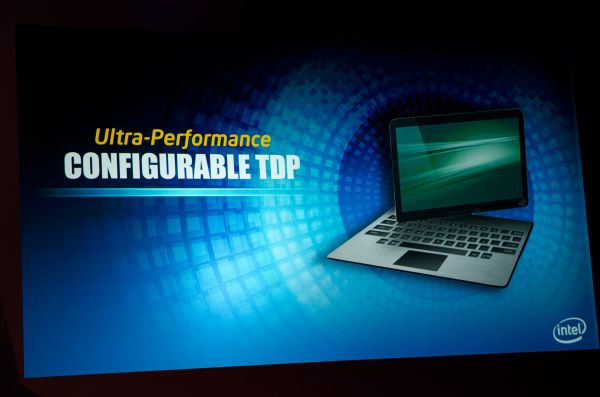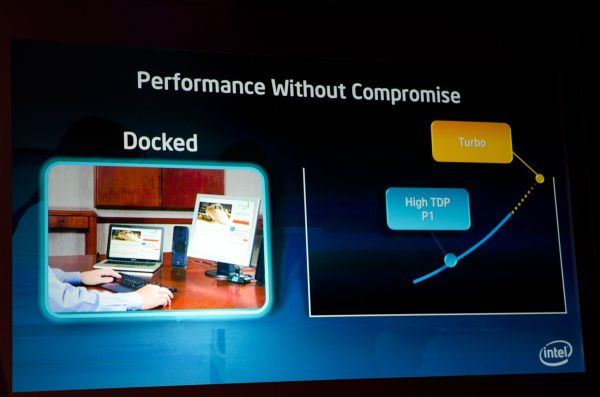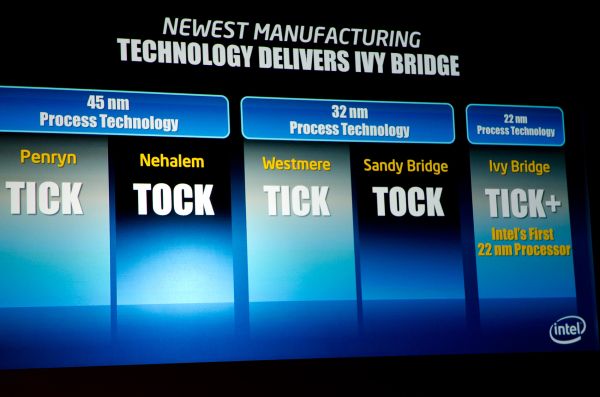Ivy Bridge: A Tick+ With Configurable TDP
by Anand Lal Shimpi on May 31, 2011 4:26 AM EST- Posted in
- Trade Shows
- CPUs
- Intel
- Ivy Bridge
- Computex 2011
With Turbo boost and power gating we took a step towards configurable CPUs. It didn't matter whether you needed one core or four, with power gating and turbo you got the best combination of active cores and clock speed. It has enabled platforms like quad-core notebooks that don't sacrifice performance in lightly threaded applications.
With Haswell Intel already committed to dropping notebook TDPs from 35 - 45W down to the 10 - 20W range. As a result you get thinner notebooks, but you do sacrifice peak performance. Intel doesn't want to make that tradeoff, so Ivy Bridge will be the first Intel CPU to introduce configurable TDP.
Ivy Bridge turbo won't just run up to the hard limits of your TDP, but it'll be able to exceed that TDP significantly (Intel wouldn't comment on the exact numbers) until the CPU gets too hot. You can imagine a 15W TDP part that could turbo up to 35W TDP for a matter of seconds to make your system feel ultra snappy without requiring a thicker notebook.
The ultra configurable TDP will also have support for a docked mode. So if you take your Ivy Bridge notebook, stick it on a docking station with better cooling you'll be able to exceed the system's TDP consistently. Now your 15W TDP part works like a 35W TDP part because you've given it more cooling.
Configurable TDP will start with Ivy Bridge, but it'll be absolutely necessary (and likely much better) with Haswell. Look at what Turbo did from Nehalem to Lynnfield and I'm guessing we'll see the same sort of transition with Ivy Bridge to Haswell.
Ivy Bridge's configurable TDP will help OEMs build ultra thin notebooks without sacrificing performance - particularly when docked.
By the way, Intel views Ivy Bridge as more than just a process shrink as a result of all of this (and more apparently). It's still not a tock, but a Tick+.


















17 Comments
View All Comments
jjj - Tuesday, May 31, 2011 - link
And this is how a 30W TDP part will be labeled 20W TDP,reminds me of AMD's ACP.mino - Tuesday, May 31, 2011 - link
Reminds me Intel TDP since NetBurst's introduction.Ah, and also AMD's ACP response 8 years later (with which they still refused to lie and call it "TDP" ...).
duploxxx - Tuesday, May 31, 2011 - link
Is this new? its just a matter of implementation. You just set a few rated tdp's and put a possible speed against it. nothing new. THis is marketing slides.Are your Intel marketing slides payed for each post you make? you could introduced this all in one thread...
Hlafordlaes - Tuesday, May 31, 2011 - link
Scram, son, the men are talking.snausage_fest - Tuesday, May 31, 2011 - link
Somehow I just know you're not exactly a beacon of manliness in real life... All the same, this is another revolutionary Intel feature that won't revolutionize anything, much less be noticed by 99% of users.Chloiber - Tuesday, May 31, 2011 - link
I also don't quite see the difference. My T410 also doesn't clock as high when unplugged as when plugged in. So obviously the TDP is also lower. This probably applies to pretty much every notebook out there.So instead of rating the CPU with the TDP it delivers with maximum performance, Intel now just rates the CPUs with the TDP they use when not plugged in.
That's marketing, I can't see anything else.
And by the way: normally, a docking station requires MORE cooling. A notebook is generally cooler when just plugged in, than when plugged in and sitting on a docking station (of course there exist huge "coolers", but that's not the general case).
stephenbrooks - Tuesday, May 31, 2011 - link
Current netbooks clock higher when plugged in, or when not plugged in, clock higher when CPU demand is high.The difference with this "configurable TDP" thing seems to be the processors can temporarily exceed even the maximum they could be run at continuously, provided the CPU is cold. I.e. 35W all the time would overheat the chip, but 35W for a few seconds is OK.
hyvonen - Tuesday, May 31, 2011 - link
Sandy Bridge is doing this already. The only difference I can think of between IB and SB is that IB turbo power limit (or turbo time limit) changes depending on cooling conditions.Mr Perfect - Tuesday, May 31, 2011 - link
I think that's mostly a function of battery power. Current laptops do not receive better cooling when running off of the wall charger, so the only limit plugging in overcomes is power. This idea of docking onto a <b>better cooler</b> to run at a higher speed is new.Jamahl - Tuesday, May 31, 2011 - link
Sounds to me like the perfect excuse for intel to segment the market and charge more for the same chip again.